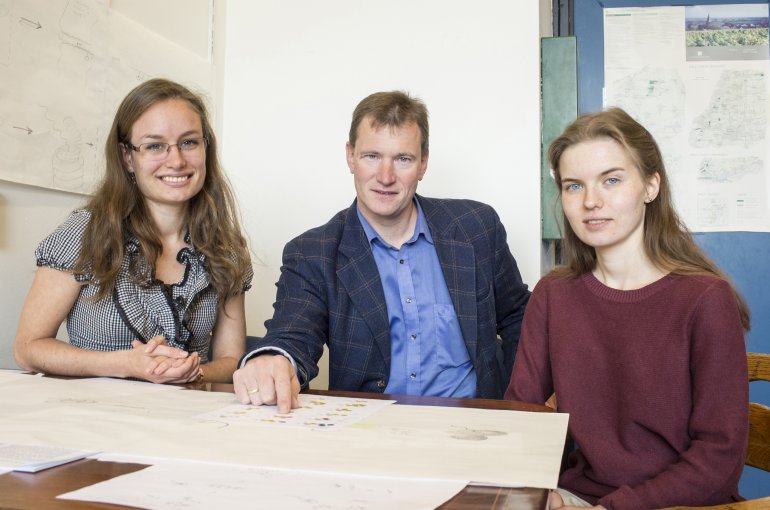Bachelor’s and Master’s students publish biochemical research article

Master’s student Dominique Hagemans and Bachelor’s student Ianthe van Belzen are first and second authors of a publication in Frontiers that has been viewed more than 190 times in 3 weeks. Together, they have developed a script that can be used in computer simulations to highlight atoms in large proteins in different colours depending on charge and hydrophobicity. This is important because these properties guide interactions with other proteins. “A good example of how our Bachelor’s and Master’s education enables students with ambition to make an impact to science at an early stage”, according to their proud supervisor Dr. Stefan Rüdiger (Chemistry).
With the hitherto available software it was possible to highlight either the charge or the hydrophobicity of the atoms, but not both. Dominique took up Rüdiger’s suggestion to combine these two characteristics in her research into Hsp90. “She saw the opportunities this presented, and has made the most of them”, according to Rüdiger. “As a result, we can now assess surface properties of Hsp90 all at once, which is essential to understand its function.” Hsp90 is an important protein in the cell, because it helps other proteins to adopt their correct, active shape. If Hsp90 does not function properly, this can lead to diseases like Alzheimer’s and Parkinson’s. In contrast, its activity becomes fatal when it is exploited by cancer cells.
Incredibly clever
Ianthe became involved in the research, as part of the honours programme during her first year studying Molecular Life Sciences, when she decided to work with Dominique to learn about laboratory work. “But when she showed me her script, I thought it would be more enjoyable to work on that. I studied Artificial Intelligence for a year and I also did some programming at high school.” Ianthe generalised the script, which made it applicable to any given protein. “She already had some programming experience but even so, she is just incredibly clever”, says Rüdiger.
Learned so much
The idea to publish their work arose during the Bijvoet Tutorial Symposium. An American visiting professor showed a great deal of interest in Dominique’s poster presentation. “Ok, then we should write it up”, Rüdiger decided. Dominique and Ianthe took up the challenge to write the paper themselves enthusiastically. “It was a lot of work, but it was also very enjoyable and I have learned so much”, says Dominique. “Not just the writing, but all the steps in the publication process make for quite an experience”, adds Ianthe.
Exactly what I was looking for
Dominique, now in the second year of her Master’s Molecular and Cellular Life Sciences, already knows that she would like to do a PhD. Ianthe, now in the second year of her Bachelor’s, is very pleased that she switched to the Molecular Life Sciences Bachelor programme. “This course is exactly what I was looking for. From here I can choose from so many different Master’s programmes, for example computational biology or bioinformatics. I already had some programming experience, but I found it very interesting to see what you can achieve with it.”
Publication
‘A script to highlight hydrophobicity and charge on protein surfaces’,
Dominique Hagemans, Ianthe A.E.M. Van Belzen, Tania Morán Luengo en Stefan G. D. Rüdiger
Frontiers in Molecular Biosciences, 13 Oktober 2015 | https://www.ncbi.nlm.nih.gov/pubmed/26528483
Life Sciences
This research is part of Science for Life, which belongs within the strategic theme Life Sciences of Utrecht University.

